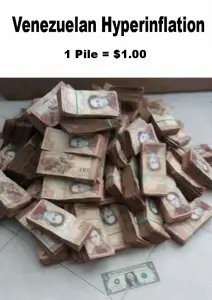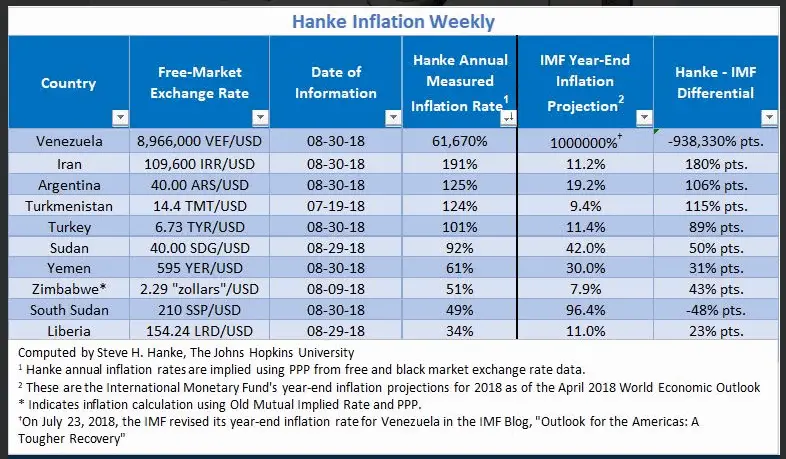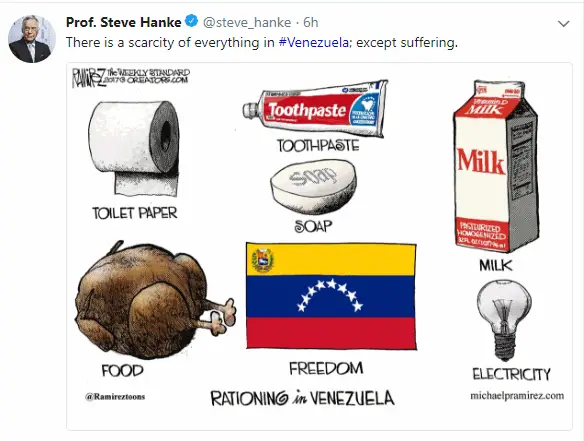It is important to note that Hyperinflation doesn’t just happen to a country’s currency for no reason. In What is Hyperinflation? we found that “Hyperinflation is an extremely rapid period of inflation, usually caused by a rapid increase in the money supply. Usually due to unrestrained printing of fiat currency.”
 Generally, the increase in the money supply is because the government can’t pay its debts so it simply prints more money, these debts are usually the result of War, Corruption, or Fiscal Mismanagement. In Venezuela’s case, the problem is not that they don’t have the assets (they have some of the largest oil reserves in the world), but rather it is a result of their economic policies. In the early 1980’s Venezuela had the highest per Capita income in South America but now it is among the poorest countries with one of the highest crime rates (including murder) in the world. As a matter of fact the murder rate is so high the government has stopped monitoring it, so it can only be estimated by NGOs.
Generally, the increase in the money supply is because the government can’t pay its debts so it simply prints more money, these debts are usually the result of War, Corruption, or Fiscal Mismanagement. In Venezuela’s case, the problem is not that they don’t have the assets (they have some of the largest oil reserves in the world), but rather it is a result of their economic policies. In the early 1980’s Venezuela had the highest per Capita income in South America but now it is among the poorest countries with one of the highest crime rates (including murder) in the world. As a matter of fact the murder rate is so high the government has stopped monitoring it, so it can only be estimated by NGOs.
Venezuela was once considered a model of the wonders of Socialism because President Hugo Chavez was initially able to tap the Oil “piggy bank”. He nationalized oil companies, utilities, and cement production. He repatriated Gold reserves from London and unlike other OPEC countries Venezuela did not establish a “Sovereign Wealth Fund” but instead destroyed the manufacturing base and spent the oil and gold reserves on unsustainable social programs. Beginning in 2001 with oil prices recovering Hugo Chavez was a local hero seen as Robin Hood by the poor of Venezuela. But oil prices are cyclical and soon their prices began to fall once more and the lack of competition, malinvestment, and no reserves began to take its toll.

Because local production was stifled, more and more commodities had to be imported. Initially, this was financed through borrowing against oil reserves but eventually lenders realized that Venezuela was not going to be able to repay their debt and so lines of credit were cut. This led to inflation and higher costs for imported goods. The government responded with price controls which resulted in shortages. Price controls weren’t just on staples like food, toilet paper, soap and toothpaste either. For instance, a few months after assuming the presidency, in November 2013, Maduro forced appliance stores to lower their prices so shortages spread to them as well. It is amazing to think how egotistical Politicians are to think that they can circumvent the laws of economics by brute force.
And today we see Venezuela in the worst depression in the history of the Western Hemisphere (worse than the great depression in the U.S.) with no end in sight. To make matters worse the charismatic Chavez died leaving the problem to his anointed (but less charismatic) successor Nicolas Maduro.
According to an estimate by Steve Hanke, professor of applied economics at the Johns Hopkins University as of August 30,2018 Venezuela’s “Bolivar” is being ravaged by hyperinflation at an annualized rate of 61,670%.
A recent article on Trading Economics says, “Venezuela introduced a new currency, the sovereign bolivar, on August 20th 2018, in an attempt to curb hyperinflation and economic crisis in the country. The new bolivar is anchored to the Petro, an oil-backed digital cryptocurrency launched in February. The exchange rate of the Petro cryptocurrency is fixed at $60, or 3,600 redenominated bolivars.” Typical of governments in hyperinflation the new currency will lop off 5 zeros of the old currency.
Will Crypto Rescue Venezuela?
According to Forbes “While the country suffers the brutal effects of hyperinflation, its socialist president, Nicolas Maduro, just mandated that the country’s banks now must accept a certain type of cryptocurrency… Money must have three attributes if it is to serve its role: a store of value, unit of account, and medium of exchange. When one of those items disappears then whatever you used to call money isn’t that anymore. In this case, the hyperinflation meant the Venezuelan Bolivar no longer acted as a store of value.”
In February 2018, Maduro launched Venezuela’s own version of Bitcoin called the “Petro” which is supposedly backed by the same oil reserves that the banks felt wasn’t sufficient collateral for the Bonds the Government was trying to issue. But somehow now that it is backing a Cryptocurrency this is supposed to make all the difference. Just like with price controls the Maduro’s Socialist government is taking the heavy handed approach and mandating that Venezuelan banks must accept the new Crypto-Currency.
According to Coingeek, “The move, which was announced early this week, has the specific aim of alleviating the economic crisis which continues to plague the country and which has been going on for several years now.”
Crypto to the Rescue?
Theoretically, cryptocurrencies are supposed to have a maximum number of units that can be created. Bitcoin does this through an algorithm that makes it progressively more difficult (and energy intensive) to “mine” Bitcoins. This fixed limit is supposed to create scarcity and increase its value. But scarcity is only one side of the supply/demand equation. The other factor is demand, i.e. without any demand even one unit of something is not valuable.
When a new Crypto is introduced they issue a “White Paper” Futurism.com says, “Typically, a white paper details the structure and backing of a given cryptocurrency, but the petro’s paper is too convoluted to actually spell any of that out. According to the paper, the petro is a “sovereign crypto asset backed by oil assets and issued by the Venezuelan State” to “spearhead for [sic] the development of an independent, transparent and open digital economy” for all of its citizens. What it doesn’t tell us, as hackernoon points out: how a petro could actually be redeemed for a barrel of oil — a glaring omission that ultimately makes the coin look pretty darn sketchy.”
The government’s scheme displays a fundamental misunderstanding of how the blockchain works. ~Futurism
So how much demand does the Petro have?
Well, even with government backing there doesn’t seem to be much demand. Perhaps because people simply don’t trust the government. Perhaps because it is unclear how the Oil backing actually works, or if the quantity is really limited or if the government can simply create more “Petros” out of thin air like they’ve done with the Bolivar. Without demand it is difficult to determine how much a “Petro” is worth. It is like a “thinly traded” stock or a one of a kind house, it is worth whatever someone is willing to pay for it. But apparently buyers aren’t queing up to buy “Petros” perhaps because they are too busy standing in lines to try and buy Bread, Toilet Paper, Diapers (Nappies), and flour.
In a similar effort, Maduro has also been pushing “gold-backed funds”, which Maduro says will allow citizens to buy “lingoticos” (little ingots). This program is scheduled to begin in mid-September. “Lingoticos”, will be certified by the Central Bank and will consist of either 1.5 or 2.5 grams of gold attached to a plastic card. Perhaps this will catch on even better than Crypto and Venezuela will become the first Country in the 21st Century to revert to a gold standard.
However, unless Maduro addresses Venezuela’s other problems, like “the highest levels of corruption in the Americas”, (according to Transparency International) along with its drug trafficking, violations of human rights, and massive corruption even a gold standard won’t be able to save Venezuela.
You might also like:
- What is Hyperinflation?
- Hyperinflation: 5 Currencies that Self-Destructed
- Confederate Inflation Rates (1861 – 1865)
- Syria in the Throes of Hyperinflation
- Zimbabwe Hyperinflation and the U.S. Dollar
- Hyperinflation in Weimar Germany
- Who Does Inflation Hurt Most?





Leave a Reply